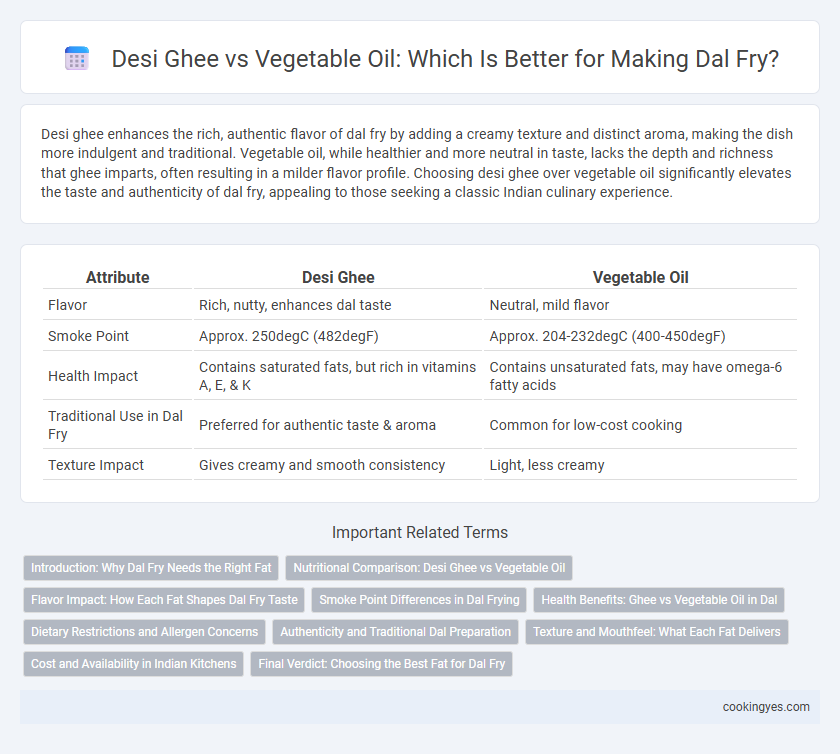Desi ghee enhances the rich, authentic flavor of dal fry by adding a creamy texture and distinct aroma, making the dish more indulgent and traditional. Vegetable oil, while healthier and more neutral in taste, lacks the depth and richness that ghee imparts, often resulting in a milder flavor profile. Choosing desi ghee over vegetable oil significantly elevates the taste and authenticity of dal fry, appealing to those seeking a classic Indian culinary experience.
Table of Comparison
| Attribute | Desi Ghee | Vegetable Oil |
|---|---|---|
| Flavor | Rich, nutty, enhances dal taste | Neutral, mild flavor |
| Smoke Point | Approx. 250degC (482degF) | Approx. 204-232degC (400-450degF) |
| Health Impact | Contains saturated fats, but rich in vitamins A, E, & K | Contains unsaturated fats, may have omega-6 fatty acids |
| Traditional Use in Dal Fry | Preferred for authentic taste & aroma | Common for low-cost cooking |
| Texture Impact | Gives creamy and smooth consistency | Light, less creamy |
Introduction: Why Dal Fry Needs the Right Fat
Dal fry requires the right fat to enhance flavor, texture, and nutritional value, with desi ghee offering a rich aroma and traditional taste that vegetable oil lacks. Desi ghee contains essential fatty acids and fat-soluble vitamins crucial for absorbing spices and enriching lentils. Choosing the correct fat influences the overall palate, making dal fry both wholesome and indulgent.
Nutritional Comparison: Desi Ghee vs Vegetable Oil
Desi ghee is rich in fat-soluble vitamins like A, D, E, and K, and contains conjugated linoleic acid which supports heart health, making it a nutritious choice for dal fry. Vegetable oil, often high in polyunsaturated fats and omega-6 fatty acids, can promote inflammation if consumed excessively, though it offers a lower saturated fat content compared to ghee. The balance of saturated fats and antioxidants in desi ghee provides enhanced flavor and potential health benefits in traditional dal recipes compared to the neutral profile of most vegetable oils.
Flavor Impact: How Each Fat Shapes Dal Fry Taste
Desi ghee imparts a rich, nutty aroma and deepens the flavor profile of dal fry, enhancing its traditional, hearty taste with buttery undertones. Vegetable oil offers a more neutral base, allowing the spices and lentils to shine without overpowering the dish's natural flavors. Using desi ghee elevates the sensory experience, making dal fry more aromatic and flavorful compared to the lighter, less intense taste when cooked with vegetable oil.
Smoke Point Differences in Dal Frying
Desi ghee has a smoke point of around 250degC (482degF), making it ideal for frying dal as it withstands high heat without burning or producing harmful compounds. Vegetable oils, such as refined sunflower or canola oil, typically have higher smoke points ranging from 230degC to 270degC (446degF to 518degF), but they lack the rich flavor and aromatic qualities of ghee in dal preparation. Choosing desi ghee enhances the taste and ensures controlled browning during dal frying, while certain vegetable oils offer slightly higher heat tolerance but less depth in flavor.
Health Benefits: Ghee vs Vegetable Oil in Dal
Desi ghee enhances the nutritional profile of dal by providing healthy fats, fat-soluble vitamins like A, D, E, and K, and conjugated linoleic acid, which supports digestion and immunity. Vegetable oil, depending on the type (such as sunflower or canola), typically offers higher polyunsaturated fats but may lack fat-soluble vitamins and contains omega-6 fatty acids that can promote inflammation if consumed excessively. Cooking dal with ghee increases bioavailability of nutrients and supports heart health when used in moderation, while vegetable oil offers a neutral flavor and lower saturated fat but requires careful selection for optimal health benefits.
Dietary Restrictions and Allergen Concerns
Desi ghee offers a rich, lactose-containing fat ideal for individuals without dairy sensitivities, while vegetable oil provides a lactose-free and vegan alternative suitable for those with dairy allergies or vegan diets. Dal fry prepared with desi ghee delivers enhanced flavor and traditional nutritional benefits like fat-soluble vitamins A and E, whereas vegetable oil options like sunflower or canola oil reduce saturated fat intake and minimize allergen risks. Choosing between desi ghee and vegetable oil depends on specific dietary restrictions, with desi ghee often avoided by lactose-intolerant or vegan individuals and vegetable oils preferred for allergen-friendly, heart-healthy cooking.
Authenticity and Traditional Dal Preparation
Using desi ghee for dal fry enhances authenticity and aligns with traditional Indian cooking methods, imparting a rich, nutty flavor that vegetable oil cannot replicate. Desi ghee's natural fats improve the dal's texture and aroma, deeply marrying the spices and lentils, which is central to classic dal recipes. Vegetable oil, while convenient, lacks the cultural resonance and taste depth essential for genuine dal preparation.
Texture and Mouthfeel: What Each Fat Delivers
Desi ghee enhances dal fry with a rich, creamy texture and a buttery mouthfeel, creating a velvety consistency that coats each lentil perfectly. Vegetable oil provides a lighter, smoother texture but lacks the depth and indulgent mouthfeel imparted by ghee. The choice between the two fats significantly influences the sensory experience, with ghee delivering a more luxurious and traditional richness.
Cost and Availability in Indian Kitchens
Desi ghee, though rich in flavor and traditional value, is significantly costlier than vegetable oil, making it a less frequent choice in many Indian kitchens for dal fry. Vegetable oil offers greater availability and affordability, ensuring widespread use across diverse households. The price difference combined with easy accessibility often drives preference toward vegetable oil in everyday cooking.
Final Verdict: Choosing the Best Fat for Dal Fry
Desi ghee enhances dal fry with rich aroma and deep flavor while providing beneficial short-chain fatty acids that aid digestion. Vegetable oil offers a neutral taste and fewer saturated fats but lacks the distinctive mouthfeel and antioxidant properties of ghee. For authentic taste and added health benefits, desi ghee is the preferred choice in dal fry preparation.
Desi Ghee vs Vegetable Oil for Dal Fry Infographic

 cookingyes.com
cookingyes.com